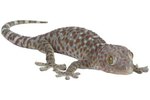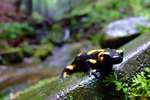
Sonoran Desert toads live in arid and semiarid parts of the American southwest and northern Mexico. Growing up to 7 inches long, these olive-colored amphibians are among the continent's biggest native toads. They live up to five years in the wild and 10 to 20 in captivity. Also called Colorado River toads, these critters depend on water more than most desert species do.
Activity Cycle
In their native environment, Sonoran Desert toads are most active after rainstorms, usually between May and late summer. During dry spells, they dig burrows or take over old rodent holes and estivate, possibly even going into torpor. When the soil becomes moist and the air humid, they emerge to congregate near pools and streams, feeding and mating.
Habitat
Provide a Sonoran Desert toad a 20-gallon tank or aquarium that has a secure, escape-proof lid -- this species is fast and strong. Give him several inches of substrate so he can burrow; coconut husk, vermiculite, soil or soil mixed with sand works well. You can use aquarium gravel as long as it’s too large for your toad to swallow. Lightly mist the substrate regularly to keep it moist. Provide ground cover and hiding places such as logs, plants or stones. Set up a large dish with filtered water, deep enough that he can sit on the bottom and thoroughly soak while being able to breathe. Clean the dish and replace the water every two to three days.
Heat and Light
Keep the enclosure between 75 and 80 degrees Fahrenheit during the day, and allow it to cool off a little in the evening. Sonoran Desert toads are most active at night, so they don’t need a supplemental light source. If you do provide extra light -- either to maintain daytime temperatures or to watch your toad in action -- use a low-watt bulb that won’t disrupt his circadian rhythm. Feeding him after dark can help maintain his natural activity patterns.
Diet
Sonoran Desert toads have massive appetites. In the wild, they eat beetles, centipedes, millipedes, grasshoppers, wasps, snails and spiders. They don’t just dine on invertebrates, though -- their diet often includes mice, small lizards and even other toads. Feed your pet toad calcium-dusted crickets, fruit flies, waxworms and mealworms. Supplement this fare with pre-killed pinkie mice. In their natural environment, Sonoran Desert toads can spend months without eating. They then gorge themselves during active periods. To avoid overindulging your pet, give him consistent, year-round access to meals and talk to a qualified vet about how much and often to feed.
Handling
All toads have parotoid glands that produce toxins, which the amphibians release when they feel threatened. Unlike most species native to the United States, though, Sonoran Desert toads secrete poison that's more than just irritating. It can be dangerous. If you must handle the toad, wear gloves and don’t touch your face until you’ve thoroughly washed your hands. The toxin has a hallucinogenic effect on people who ingest it, and it can paralyze or kill dogs who mouth or lick the toads. Consult your vet immediately if a child, dog or other pet has contact with your Sonoran Desert toad.
References
- Arizona-Sonora Desert Museum: Sonoran Desert Toad (Bufo Alvarius)
- California Herps: Incilius Alvarius -- Sonoran Desert Toad
- University of Michigan Museum of Zoology: Incilius Alvarius -- Sonoran Desert Toad
- Arizona Game and Fish Department: Wildlife Field Notes: Sonoran Desert Toad
- Reptile City: Bufo Alvarius
Photo Credits
-
Jupiterimages/Photos.com/Getty Images



